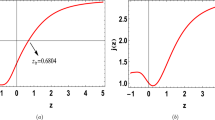Abstract
The problem of the local Hubble flow on scales of several Mpc induced by the dark energy realized by a scalar quintessence field is considered within the framework of relativistic gravity theory (RGT). The observational Hubble Space Telescope data are shown to be well described in RGT by a model similar to the Chernin–Baryshev–Teerikorpi model constructed in general relativity, with the local Hubble constant being smaller than the cosmological Hubble constant. A stringent constraint has been placed on the quintessence parameter, 0 ≤ ν ≤ 0.05.
Similar content being viewed by others
References
A. Sandage et al., “The Hubble constant: a summary of the HST program for the luminosity calibration of type Ia supernovae by means of Cepheids,” Astrophys. J. 653, 843–860 (2006); arXiv:astro-ph/0603647.
A. Sandage et al., Astrophys. J. 527, 479 (1999).
A. D. Chernin, “Dark energy and universal antigravitation,” Phys. Usp. 51, 253–282 (2008).
A. Chernin, P. Teerikorpi, and Yu. Baryshev, “Why is the Hubble flow so quiet?,” Adv. Space Res. 31, 479 (2003); astro-ph/0012021.
A. D. Chernin, “Cosmic vacuum,” Phys. Usp. 44, 1099 (2001).
I. D. Karachentsov et al., “The Hubble flow around the local group,” Mon. Not. R. Astron. Soc. 393, 1265–1284 (2009); astro-ph/0811.4610.
A. Kogut et al., Astrophys. J. 419, 1 (1993).
A. D. Chernin, “Dark energy in the nearby Universe: HST data, nonlinear theory, and computer simulations,” Phys. Usp. 56, 704–709 (2013).
G. Hinshow et al., arXiv:1212.5226.
A. A. Logunov and M. A. Mestvirishvili, The Relativistic Theory of Gravitation (Nauka, Moscow, 2011; Mir, Moscow, 1989).
A. A. Logunov, M. A. Mestvirishvili, and Yu. V. Chugreev, “Graviton mass and evolution of a Friedmann universe,” Theor. Math. Phys. 74, 1 (1988).
Yu. V. Chugreev, “Cosmological consequences of the relativistic theory of gravitation with massive gravitons,” Theor. Math. Phys. 79, 554 (1989).
S. S. Gershtein, A. A. Logunov, M. A. Mestvirishvili, and N. P. Tkachenko, “Graviton mass, quintessence, and oscillatory character of Universe evolution,” Phys. At. Nucl. 67, 1596 (2004).
M. A. Mestvirishvili, K. A. Modestov, and Yu. V. Chugreev, “Quintessence scalar field in the relativistic theory of gravity,” Theor. Math. Phys. 152, 1342 (2006).
S. S. Gershtein, A. A. Logunov, and M. A. Mestvirishvili, “Gravitational field self-limitation and its role in the Universe,” Phys. Usp. 49, 1179 (2006).
S. S. Gershtein, A. A. Logunov, and M. A. Mestvirishvili, “Cosmological constant and Minkowski space,” Phys. Part. Nucl. 38, 291 (2007).
Yu. V. Chugreev, “The vacuum cosmological solution is unique in the relativistic theory of gravity,” Theor. Math. Phys. 161, 1420 (2009).
Yu. V. Chugreev, “Post-Newtonian approximation of the relativistic theory of gravitation on a cosmological background,” Theor. Math. Phys. 82, 328 (1990).
S. M. Kopeikin and A. Petrov, “Post-Newtonian celestial dynamics in cosmology: field equations,” Phys. Rev. D: Part. Fields 87, 044029 (2013); arXiv:1302.5706 [gr-qc].
V. N. Lukash and V. A. Rubakov, “Dark energy: myths and reality,” Phys. Usp. 51, 283–289 (2008).
arXiv:1502.01589.
P. J. E. Peebles, Principles of Physical Cosmology (Princeton Univ. Press, Princeton, 1993).
Author information
Authors and Affiliations
Corresponding author
Additional information
Original Russian Text © Yu.V. Chugreev, 2016, published in Pis’ma v Zhurnal Fizika Elementarnykh Chastits i Atomnogo Yadra, 2016.
Rights and permissions
About this article
Cite this article
Chugreev, Y.V. Dark energy and graviton mass in the nearby universe. Phys. Part. Nuclei Lett. 13, 38–45 (2016). https://doi.org/10.1134/S1547477116010088
Received:
Published:
Issue Date:
DOI: https://doi.org/10.1134/S1547477116010088




